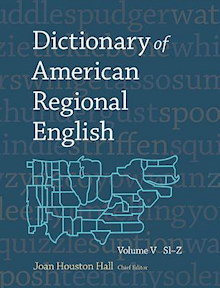Dictionary of American Regional English
It is one of the hallmarks of lexicography that those who engage in it are destined for the long haul. A marked tendency exists for the initiators of dictionary projects to suffer the fate of Moses and not survive to witness the end of their endeavours. James Murray never saw the Oxford English Dictionary in its completed state. Likewise Professor Fred Cassidy, who began the work of compiling what has become an extraordinary five-volume work, the Dictionary of American Regional English, died some years before the final volume went to press.

But now we have all five volumes, a stack 11in (28cm) high weighing 28 pounds (13 kg), comprising some 5,500 pages. Such crudely gross measurements do little to communicate the labour of nearly half a century that has been put into editing and compiling the work. In strict truth, the project had been put in motion more than a century ago, in 1889, when the American Dialect Society was founded to make a work that would rival Joseph Wright’s English Dialect Dictionary. A great amount of material had already been collected in a rather haphazard way when in 1962 Professor Cassidy, Professor of English at the University of Wisconsin-Madison, was appointed editor by the Society. Fieldwork began in 1965 and took five years. Researchers went to more than a thousand communities in all 50 states, asking hundreds of questions of 2,777 individuals about their words for everything from time and weather to domestic animals to courtship and marriage to children’s games. These interviews were augmented by a volunteer reading programme of newspapers, diaries, biographies, letters, histories, novels and government documents. More recently, the vast resources opened up through documents being digitised and made available online has made the compiler’s job — as the preface to this final volume comments — “much more challenging while at the same time distinctly more rewarding”.
In those 5,500-odd pages we now have a record of the regional speech of the US, taken at a time when the march towards conformity through widespread exposure to the national media hadn’t progressed as far as it has today. However, that snapshot has been updated with much subsequent research work, particularly in the later volumes, which confirms that regional American speech is still very much alive.
What comes across most strongly is its diversity. The survey found 79 names for the dragonfly, for example, including mosquito hawk, snake feeder, ear-cutter and sewing needle. The fluff under the bed may be described as dust kitties, dust bunnies, woolies or house moss. A sandwich may be a po’boy, hoagie, sub, grinder, hero or torpedo. A remote locality can be the boondocks, the puckerbrush, the tules or the willywags. The strip of grass between what I call the pavement (American sidewalk) and the kerb (or curb) can be the berm, devil’s strip, parking, street lawn, tree box, tree lawn, tree court, tree terrace, parkway, double strip, parking strip, verge or swale. (The only British name I know for it is verge, in full grass verge. UK readers may feel deprived.)
In this fifth volume alone appear spatzie for a sparrow; Tom show, a travelling production of Uncle Tom’s Cabin; yes-ma’am or thank-you-ma’am, a sudden or startling dip or bump in the road, and upscuddle, a noisy quarrel. In the southern states to step off the carpet, or just to step off, is to get married; out west at one time a horse that bucked violently was said to unwind; a century ago a squirrel load was a very small drink of hard liquor; in Wisconsin on the other hand a whoopensocker is a large or strong drink but also an extraordinary thing; if you’re caught in the Wewoka switch you are utterly lost, though you will be in Oklahoma, the only state where the expression is recorded; a tin can alley is a poor or shabby part of town (so first cousin to one of the early meanings of tin pan alley); and in the south Appalachians a swarp is a blow or an attempt. Once you start reading entries you’re lost.
The pity is that the cost of the complete set ($545.45) is beyond the pockets of most readers, who will have to hope that some nearby library has the funds to acquire one. There is a proposal to put the whole dictionary online next year, which will be wonderful if it’s priced economically. We can hope that it will add an invaluable research tool that’s impossible in the printed volumes: the ability to extract vocabulary by state or region, so enabling researchers to study the work by locality and allow writers to ensure that their language is geographically consistent.
[Joan Houston Hall [ed.], Dictionary of American Regional English, volume 5; Hardcover, pp1296; published by the Belknap Press of Harvard University Press, 20 March 2012; ISBN: 9780674047358; publisher's price $85.00. Earlier volumes are also available, at $124.50 for vols I-III and $89.95 for vol IV.]
